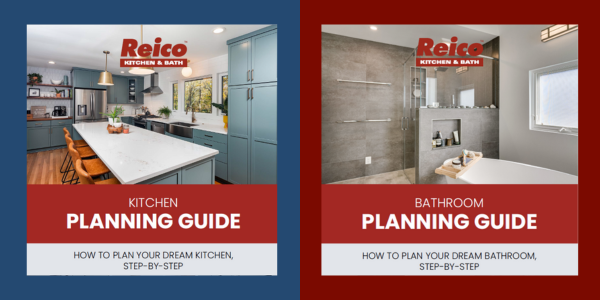Kitchen and Bathroom Cabinet Basics - what you need to know
Along with your appliance choices, selecting cabinets early on will help you make other decisions regarding your new kitchen or bathroom design. Learn more about Reico's cabinet brands here, or visit our Reico Express page for in stock cabinets and other products you need quickly.
Maybe you are not there yet. That is okay. Selecting the right cabinets is an important decision in the design and remodeling process. The look of your kitchen cabinets or bathroom cabinets, be it the wood species, the door style, the finish color or most often all of it combined, impacts the feel of the entire space. In most cases, people are drawn to 2 main aspects – the wood species and the cabinet finish.
The wood species plays a large role in determining the look of your cabinets as well as the cost. Keep in mind that all wood will darken over time to varying degrees based upon species (oak darkens the least; cherry the most). Normal inconsistencies such as color variations, mineral streaks, black marks and wild grain patterns will be visible in every wood door in your kitchen regardless of species. If it is perfect, it is plastic! Here are some popular wood door options:
- Oak: Grainy to the touch, red tones, most economical.
- Maple: Closed grain, very consistent in color, yellowish tones.
- Pecan/Hickory: Wild mineral streaks create inconsistencies in finish.
- Cherry: Visible graining with red tones and a lot of color variation.
- Alder: Straight, fine textured wood, light in weight with a beautiful natural honey tone.
- Walnut: Dark wood, rarity of wood results in longer than average lead times.
You can also consider alternatives to wood such as Thermafoil (a fiberboard door with heat applied wrap finish) or Laminate (a furniture board core covered with laminate). Both are available in a variety of colors and patterns.
The most common and typically most cost-efficient cabinet finish is a stain. A more popular option is a painted finish. This is a more expensive option as a painted cabinet finish will require several more coats for a clean, crisp finish. Over time this type of finish will show seams and cracks due to expansion and contraction of wood. You can also consider additional finishing effects to give your cabinets a more distinct and unique look. Popular finishing effects include glazing and distressing with more options available.
The style of a cabinet door will also influence the appearance of your kitchen or bathroom. Here are some common definitions to give you a brief idea of what to look for in choosing your desired cabinet door style:
- Traditional Overlay: cabinet doors and drawers that leave portion of the cabinet’s face frame visible.
- Full Overlay: cabinet doors and drawers cover most or all of cabinet face frame (or cabinet box if frameless cabinet) for cleaner look.
- Inset: cabinet doors and drawers sit within cabinet, flush with cabinet frames.
These doors can come as flat (center panel of cabinet door is recessed), raised (center panel is raised) or as a slab (one flat continuous surface). In some cases, depending on the door style, you can also choose between a standard drawer front or a more decorative 5-piece drawer front that more closely resembles the door profile.
Finally, consider the cabinet’s construction. A framed cabinet consists of a cabinet box with an attached face frame, with doors and drawer fronts attached to that frame. An alternative is the frameless cabinet. A frameless cabinet consists of the cabinet box with the doors and drawers attached to the inside of the cabinet since no frame exists. It offers a sleeker, full overlay look with more usable open space than its’ framed cabinet counterpart. You can also consider additional construction options including but not limited to the following:
- Plywood Sides: standard cabinet sides typically use a furniture board core with a laminated finish. Consider upgraded sides using plywood and matching finished wood veneers, or go all in with all-plywood construction if available.
- Wood Dovetail Drawers: standard drawer core construction uses particleboard sides that are pinned together. Consider a wood drawer core constructed with interlocking “dovetail” joints.
- Full Extension Undermount Drawer Guides: standard drawer guides can typically be found on the side of the drawer core, and extend almost all the way out of the cabinet. Full extension drawer guides are mounted under the drawer box offering a smoother motion, less play and in some cases a slightly larger drawer.
Discuss with your designer the cabinet options that are most important to you and how that can affect your budget. It is important to have a detailed conversation so that your kitchen cabinet or bathroom cabinet selections bring the proper look and feel to your space and the products around it.

